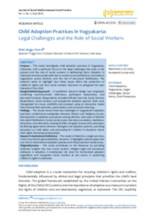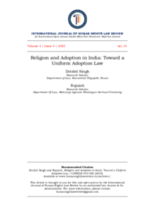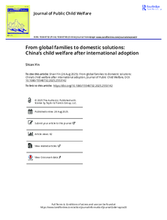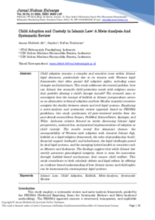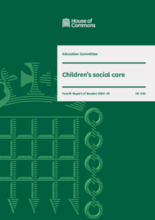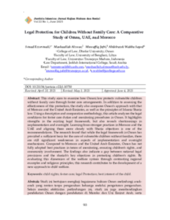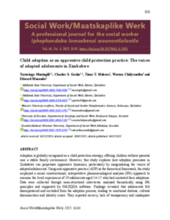Displaying 11 - 20 of 653
This study examines adoption practices in Yogyakarta, Indonesia, highlighting legal challenges such as jurisdictional ambiguities, inconsistent procedures, and document falsification. It emphasizes the crucial role of social workers in navigating these obstacles, advocating for children’s rights, and supporting families throughout the adoption process.
India’s adoption laws have evolved over more than a century, creating parallel systems that affect eligibility, speed of adoption, and the rights of adoptive families. This study examines the historical origins and gaps in these laws and advocates for a unified framework that aligns with constitutional and international standards.
China’s decision to end its international adoption program after 30 years affects over 160,000 children, many with disabilities, raising concerns about increased institutionalization and developmental risks. This commentary highlights the need for reforms such as expanding domestic adoption, improving foster and kinship care, enhancing institutional quality, and strengthening cross-sector collaboration to create a more family-centered child welfare system.
Child adoption remains a complex and sensitive issue within Islamic legal discourse, particularly due to its tension with Western legal frameworks that often permit full adoptive rights, including name changes and inheritance. This study addresses the central problem: how can Islamic law reconcile child protection needs with religious norms that prohibit altering a child’s lineage? The research aims to investigate how the concept of kafalah in Islamic jurisprudence serves as an alternative to formal adoption and how Muslim-majority countries navigate the duality between sharia and civil legal systems.
In this video, practitioners, faith leaders, and a Kafaalah caregiver share experiences in promoting and strengthening Kafaalah as an important part of family-based alternative care in Kenya.
This study examines Algeria’s use of kafala as a legally recognized alternative to adoption, highlighting its role in protecting the identity and citizenship rights of children of unknown parentage. While kafala aligns with Islamic principles and offers a protective framework, legal gaps, administrative barriers, and social stigma persist, underscoring the need for reforms to ensure children’s full legal identity and social inclusion.
This report makes a series of recommendations on issues affecting all types of care, including foster care, adoption, kinship care, children’s homes, and support for disabled children in the UK.
This study analyzes how Omani law protects vulnerable children without family care through foster arrangements, comparing it with practices in Morocco, the UAE, and the principles of Islamic Sharia law. While Oman’s legal framework provides a foundation for care, the research highlights weaknesses in implementation and oversight, recommending stronger monitoring, greater community involvement, and closer alignment with both regional best practices and Sharia objectives.
Adoption in Zimbabwe, while intended to provide stable families for children without parental care, often marginalizes adopted adolescents by excluding them from decisions, limiting transparency, and severing cultural ties. This study highlights the emotional distress and identity challenges this creates and calls for more inclusive, transparent, and culturally grounded adoption practices that uphold children’s rights and voices.
Using interdisciplinary analysis, Kit W. Myers examines the adoption of Asian, Black, and Native American children by White families in the United States. He shows how race has been constructed relationally to mark certain homes, families, and nations as spaces of love and better futures—in contrast to others that are not.

